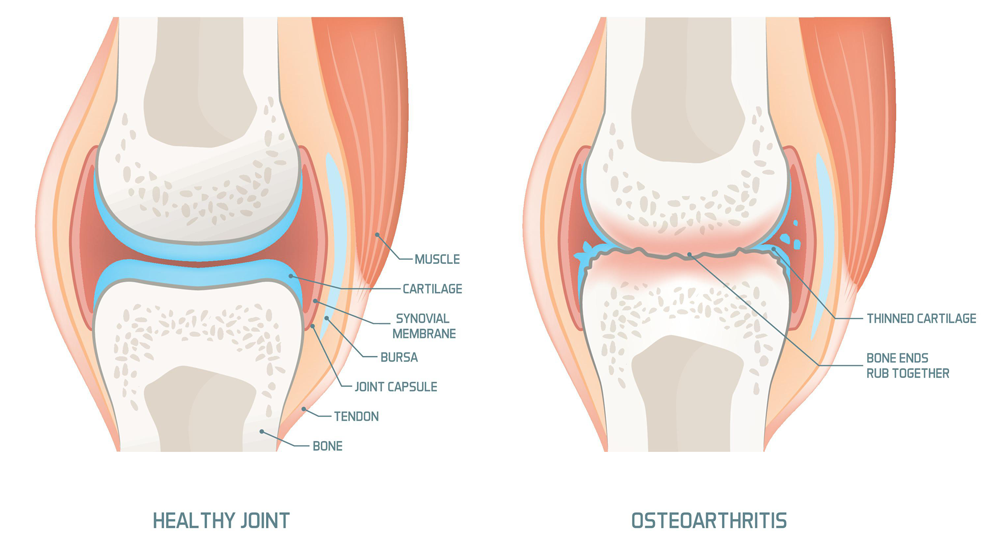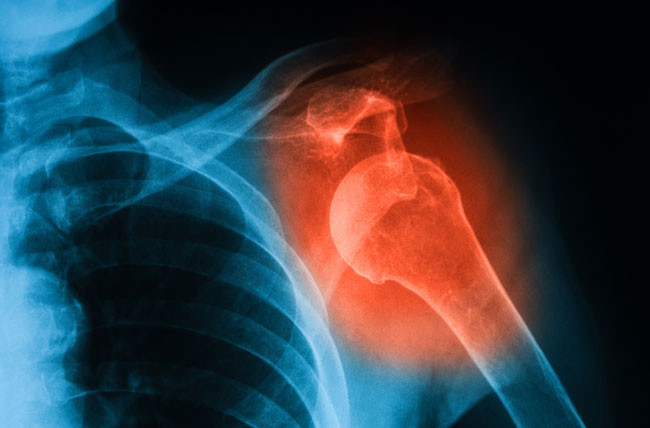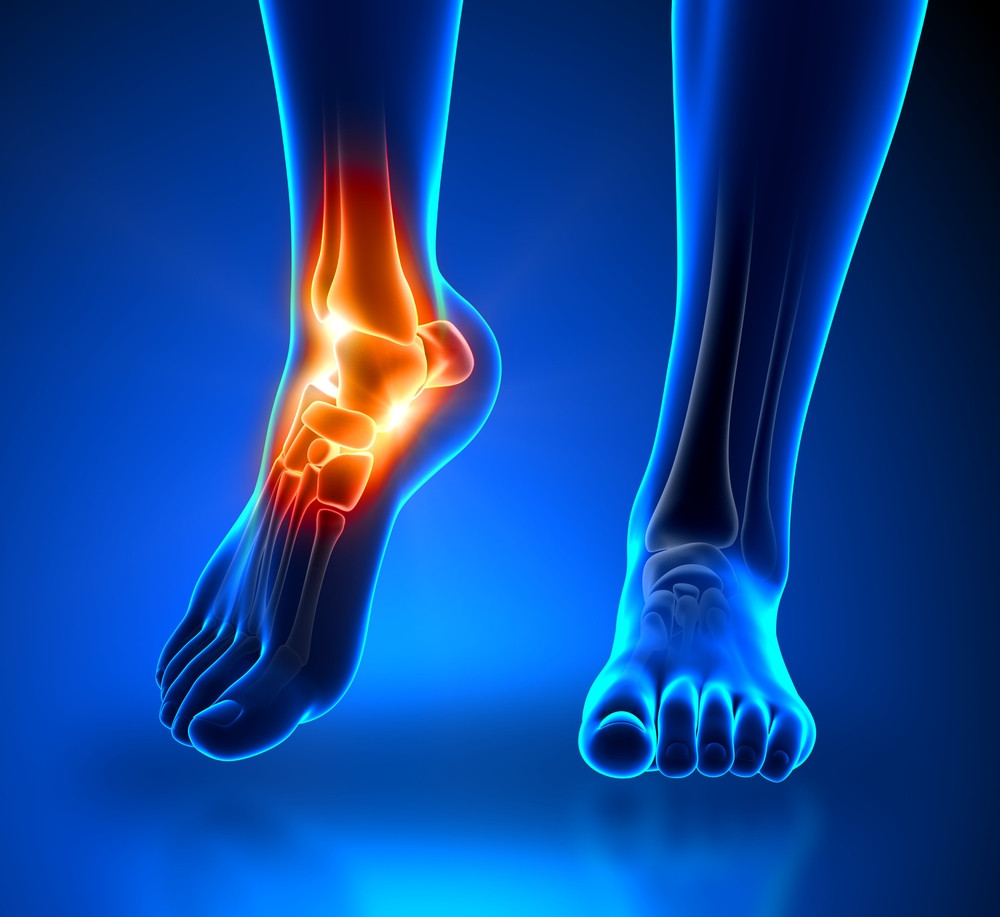Definition
Frozen shoulder, or adhesive capsulitis, is a condition characterized by stiffness and pain in the shoulder joint. Over time, the shoulder may become increasingly difficult to move. This rare condition involves the thickening and contraction of the muscles surrounding the shoulder joint. According to the American Academy of Orthopaedic Surgery, it affects about 2% of the population. Physical therapy to improve shoulder flexibility is the recommended treatment for patients with frozen shoulders.
Causes
The shoulder joint is composed of three bones: the upper arm bone, the shoulder blade (scapula), and the collarbone (clavicle). A strong connective tissue known as the shoulder capsule surrounds the joint. The joint fluid lubricates the joint, enabling smooth shoulder movement.
In a frozen shoulder, the shoulder capsule thickens and becomes stiff, restricting shoulder movement. A reduction in joint fluid is also noted in many cases. However, the exact cause of the frozen shoulder is not fully understood. It is suspected to be more likely in individuals recovering from an upper arm fracture or surgery, leading to prolonged immobilization of the shoulder.
Risk factor
Several factors may increase the risk of developing a frozen shoulder, including:
- Prolonged shoulder immobility: Recovery from surgery involving the shoulder or upper limbs, or an arm fracture, can increase the risk.
- Underlying medical conditions: Certain illnesses, such as diabetes mellitus, thyroid disorders (hyperthyroidism or hypothyroidism), heart disease, and Parkinson’s disease, are associated with a higher likelihood of frozen shoulder.
- Age and gender: Individuals between the ages of 40 and 60, especially women, are more prone to developing this condition.
Read more: Fracture Diseases - Definition, Causes, Symptoms, and Management
Symptoms
Patients may experience dull pain in the outer shoulder, sometimes radiating to the upper arm. Symptoms typically worsen with arm movement. For some, pain intensifies at night, disrupting sleep. Over time, symptoms improve, and a frozen shoulder rarely recurs in the same shoulder.
The signs and symptoms of a frozen shoulder generally progress through three stages:
- Freezing stage
Shoulder movement causes pain, and as the pain worsens, the shoulder becomes stiff and difficult to move. This stage can last from 2 to 9 months.
- Frozen stage
Pain may diminish, but stiffness increases, making shoulder movement more restricted and daily activities challenging. This stage can last 4 to 6 months.
- Thawing stage
Gradual improvement occurs, and shoulder mobility begins to return, with complete recovery taking anywhere from 5 to 26 months.
Diagnosis
The doctor will inquire about your symptoms and medical history in detail. During a physical examination, you will be asked to move your shoulder, and the doctor will gently manipulate the shoulder to assess a range of motion limitations.
To rule out other conditions that may cause stiffness and pain, additional imaging tests may be conducted:
- X-ray
Helps detect changes in bone structure over time and rule out other issues like arthritis.
- MRI and Ultrasound
These tests assess soft tissues around the shoulder for injury or other abnormalities.
Read more: Arthritis - Definition, Causes, Symptoms, and Management.
Management
Frozen shoulder usually improves over time, although it may take up to three years. The goal of treatment is to manage pain and stiffness while maintaining the shoulder's range of motion. According to the American Academy of Orthopaedic Surgery, more than 90% of patients improve with non-surgical treatment options.
Here are the treatments available for frozen shoulder:
- Medications
Over-the-counter pain relievers such as ibuprofen and acetaminophen can help reduce pain and inflammation. Steroid injections into the shoulder joint may alleviate pain and improve mobility, particularly in the early stages of a frozen shoulder. In some cases, stronger pain relievers and anti-inflammatory medications may be prescribed.
- Physical therapy
Physical therapy focuses on restoring mobility and range of motion in the shoulder through supervised stretching and exercises. Consistency in performing these exercises is crucial for maximizing recovery.
- Surgery and other procedures
If symptoms persist and do not improve over time, and non-surgical treatments are ineffective, surgery may be recommended. Surgical intervention is usually considered during the frozen stage. The aim is to stretch and release the stiffened shoulder capsule.
-
- Shoulder manipulation
This procedure involves general anesthesia so that the patient is unconscious and pain-free. The doctor moves the shoulder joint in different directions to stretch the stiff tissues.
-
- Shoulder arthroscopy
The surgeon makes small incisions around the shoulder to cut through the stiffened parts of the shoulder capsule.
Complications
If left untreated, a frozen shoulder can result in:
- Chronic shoulder pain.
- Limited shoulder range of motion, potentially leading to a total inability to move the shoulder.
- Long-term muscle problems that worsen over time.
While a frozen shoulder rarely recurs in the same shoulder, it can affect the opposite side in some cases.
Prevention
One of the most common causes of a frozen shoulder is immobility during recovery from shoulder injuries, arm fractures, or strokes. If you have experienced an injury that limits shoulder movement, talk to your doctor about exercises that can help maintain the shoulder joint’s range of motion.
Prevention
One of the most common causes of a frozen shoulder is immobility during recovery from shoulder injuries, arm fractures, or strokes. If you have experienced an injury that limits shoulder movement, talk to your doctor about exercises that can help maintain the shoulder joint’s range of motion.
When to see a doctor?
If you experience pain, stiffness, or limited movement in your shoulder joint, it is advisable to consult a doctor for a thorough evaluation. Your doctor will help address your symptoms, identify potential causes, and recommend treatments or exercises to preserve your shoulder’s mobility.
Looking for more information about other diseases? Click here!
- dr Hanifa Rahma
Frozen shoulder - Symptoms and causes. (2022). Retrieved 19 August 2022, from https://www.mayoclinic.org/diseases-conditions/frozen-shoulder/symptoms-causes/syc-20372684.
Frozen Shoulder Symptoms, Causes and Treatment | UPMC. Retrieved 19 August 2022, from https://www.upmc.com/services/orthopaedics/conditions-treatments/frozen-shoulders.
Frozen Shoulder - Adhesive Capsulitis - OrthoInfo - AAOS. (2018). Retrieved 19 August 2022, from https://orthoinfo.aaos.org/en/diseases--conditions/frozen-shoulder/.











